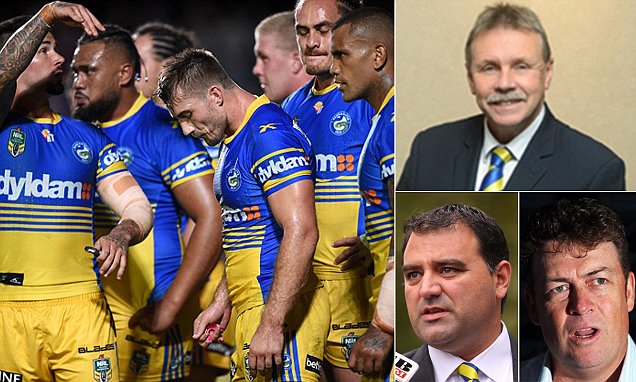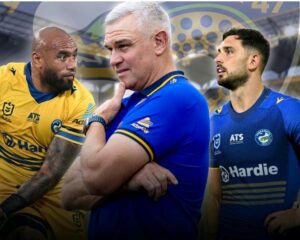
Eels’ Roster Ransom: Handcuffed by Loan Deals, $975k Star Puts Club in Headlock..
Parramatta’s rebuilding journey under new head coach Jason Ryles is being severely tested — not just by on-field results, but by off-field constraints. The Eels find themselves in what some insiders are calling a roster ransom: dozens of players in limbo on loan agreements, limited flexibility to move freely, and pressure mounting around a $975,000-a-year veteran whose contract situation demands resolution.
—
The Loan‐Deal Logistics: Dozens in Limbo
One of the key structural issues the Eels face is the proliferation of loan deals across their squad. As part of their roster rebuild, the club has sent multiple players out on loan, tied into arrangements that limit flexibility and complicate squad planning. According to recent analysis, around a dozen players are currently “in limbo” — neither fully available to Parramatta nor free to be permanent transfers or departures.
These loan deals, while potentially intended to give fringe players game time and reduce salary burden, end up constraining the club’s hands. The Eels can’t simply recall or move those players without navigating contractual obligations and negotiating terms with host clubs. In effect, the club is hostage to the very roster flexibility it once hoped to build.
Further compounding the issue is timing — as Ryles tries to sculpt the squad ahead of next season, the fate of those loaned players becomes a bottleneck. The Eels’ ability to bring in reinforcements, reshape depth charts, or absorb injuries is weakened by the uncertainty around who will return, who departs, and who remains locked in sub-optimal contracts.
In short: the loans that were meant to free up space are ironically trapping Parramatta in a web of conditional commitments.

The $975K Star: Contract Pressure Cooker
At the center of the roster drama is an unnamed veteran whose reported salary is $975,000 a year — making him one of Parramatta’s highest-earners. The club is now facing a pivotal “contract call” on this player: either reaffirm him, renegotiate, release, or pivot. The decision will reverberate throughout the roster.
To retain him under favorable terms would require space, both in salary cap and in roster slots — things that are currently squeezed by the tangled web of loan deals. To let him go or demand a pay cut risks backlash from fans, the player, and his agent. The club is stuck between enabling continuity and preserving flexibility.
Moreover, the optics are delicate. This veteran’s presence is symbolic of Parramatta’s premium investments in talent; letting him roam uncertainly sends a precarious message about the club’s stability. The expectation among pundits is that the Eels must make a definitive call soon to stop the rot: either commit or cut ties.
Thus the phrase “roster ransom” is apt — a high-earner’s future is being held hostage by the inadequacies and overcommitments in the wider squad.
—
Strategic Fallout: Rebuild Hits Roadblocks
The timing of these complications is particularly injurious, given Parramatta is in a critical phase of squad reorganization. Ryles arrived on a mandate to refine, reshape, and retool — but the administrative and contractual baggage threatens to derail the rebuild.
One immediate casualty is recruitment flexibility. As the club remains entangled with players whose futures are unresolved, their ability to recruit new talent — or shift existing ones — is hampered. The club risks missing windows in the market, especially with rivals already locking deals.
Secondly, morale and clarity within the squad suffers. When players see uncertainty in loan arrangements and marquee contract limbo, it can erode faith in the direction of the club. Ryles and management must reassure the wider roster that there is a coherent strategy, not just reactive versioning.
Thirdly, the salary cap behaves like a cage. With funds committed to existing contracts and restricted by loan deals, Parramatta may struggle to allocate resources where needed (injuries, midseason signings, depth). The club must balance honoring existing deals with creating breathing room.
If left unresolved, these pressures could cascade into performance declines — especially as the squad faces attrition, fatigue, and the usual rigors of a full NRL campaign.
—
Possible Paths Forward
Despite the constraints, the Eels do have possible routes out of the quagmire — though none are without risk.
1. Contract renegotiation or buyout.
One option is to sit down with the $975,000-earner and renegotiate terms (salary cut, shorter tenure, performance incentives). If agreeable, this would free up cap space and send a positive message of collective sacrifice. If not, a mutual termination (buyout) could be forced, though that comes with short-term financial pain and reputational cost.
2. Recall or terminate certain loans.
If Parramatta can negotiate with host clubs, they might recall some loanees early or convert loans into permanent transfers (in or out). This would release pressure on squad slots and allow clearer decisions for depth management.
3. Offload redundant high earners.
Beyond the $975k star, the club can examine whether other high-wage players (especially fringe or underutilized) can be traded, released, or loaned out permanently. Freed cap space could reallocate to pressing gaps.
4. Incremental restructure and staggered release.
Rather than mass upheaval, the Eels could phase exits and signings across windows, reducing disruption. That requires tight coordination and discipline in contract design.
5. Transparent public narrative.
The club must manage perceptions. A clear message from Ryles and management about where the rebuild is headed, how decisions are made, and how the players fit can stem speculation and maintain fan confidence.
—
Risks and Stakes
The window for decisive action is tight. If Parramatta fails to act, they risk:
Roster stagnation — unable to adapt midseason, respond to injury, or exploit emergent talent.
Cap stress — overspending or underutilization may force scrambles and reactive decisions.
Player dissatisfaction — top talent may seek escape, believing the club is not committed to a coherent strategy.
Competitive decline — while rivals solidify, Eels could slip in ladder position or fail to sustain performance.
Conversely, successfully navigating the crisis could leave Parramatta leaner, more flexible, and better poised for sustained success.
—
The Road Ahead
At this moment, the Eels’ roster looks less like a polished tool and more like a beleaguered arsenal held ransom by contractual binds. The coming weeks (or even days) may force Ryles and the board into a showdown — a decision point on which the direction of the club leans.
If they act decisively — cutting losses, rebalancing, renegotiating — they can salvage flexibility and restore internal confidence. If they drift, the weight of loan deals and a high-paid veteran with uncertain status may drag the Eels backward rather than forward.
Ultimately, the phrase “roster ransom” may yet define this Parra chapter: whether a club under siege can break free and reclaim control.
Leave a Reply